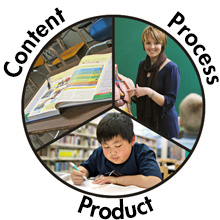Differentiated Instruction: Maximizing the Learning of All Students
Wrap Up
 Differentiated instruction is an approach in which teachers adjust their curriculum and instruction to maximize the learning of all students. Teachers can adjust three main instructional elements: content, process, and product. There are also three student characteristics that teachers should consider when planning instruction: readiness, interests, and learning profile. In addition, teachers who differentiate instruction employ ongoing assessment and flexible grouping.
Differentiated instruction is an approach in which teachers adjust their curriculum and instruction to maximize the learning of all students. Teachers can adjust three main instructional elements: content, process, and product. There are also three student characteristics that teachers should consider when planning instruction: readiness, interests, and learning profile. In addition, teachers who differentiate instruction employ ongoing assessment and flexible grouping.
View the movie below to hear Carol Ann Tomlinson discuss five key aspects of differentiated instruction (time: 4:07).
Transcript: Wrap Up
A couple of years ago, one of my students, who was an undergraduate preparing to be a teacher, gave me a definition of differentiation that has become my favorite one. He began his definition by saying that differentiation is a sequence of common-sense decisions made by teachers with a student-first orientation. It seems exactly what we should be doing. He went on to tell me what he thought the sequence of common-sense decisions was. He listed four things, and I would add a fifth one to that.
First, he said it’s critically important to consciously be aware of creating a classroom environment that invites kids to the table of learning, that encourages them to take the risk of learning, that helps them understand that they need to work hard and shoot high, but also causes them to understand that there’s a support system there to help with that. So the first piece is developing an environment that actively encourages learning, and my sense is that affects everything else.
Second, he said he thought it was really critical that we have high-quality curriculum that engages kids and that we be able as teachers to say at any point here’s what kids should know, what they should understand, what they should be able to do as a result of this sequence of learning. In other words, it matters that we have clear learning targets, that they are understanding-focused, that they’re clear to us and clear to kids, and that we have organized learning around those in such a way that it makes sense to kids, that it’s relevant to them.
Third, he said he thought it was really important that we continue to check to see where kids are constantly, relative to those learning outcomes. Not teach a whole unit then give a test and say, well, gee, some of them got it and some of them didn’t. But using preassessment and using formative assessment consistently so that we have a good sense at any particular moment of who’s confused, who’s behind, who’s ahead, and who’s missing knowledge.
Then he said the fourth step was that, when you monitor the kids using formative assessment, you’re likely to find out they aren’t all in the same place, and so it becomes instructionally important to say, okay, now, how do I tailor my lesson plans tomorrow or this week so that I can get to kids where they are? When do I need to meet with some kids in small groups and for what purpose? Are there students who need to be using different resources? Is there a different way I can help kids that didn’t understand this yesterday try to wrap around it today? Those were his four elements.
My fifth one is that we have to learn as teachers to lead and manage a classroom in which it’s possible for more than one thing at a time to happen. As long as we ask kids to start and stop everything together, always use the same materials, always do stuff in exactly the same way, we’ll hinder a lot of learning. And so it becomes really critical that we learn as teachers to help kids be our partners in creating a classroom which allows for flexibility but which also has clear structures that give kids and teachers the stability and predictability that they need. For me, differentiation is a continuum; it’s not a point. And you don’t get to a point and say, well, okay, I’ve finished that. It’s always a question of, okay, let me acknowledge what I do and then let me look at some rubrics, some standards, some examples of teachers, some writings, some videos, anything I can look at that can continue to help me stretch and think through what I can do better. The people that I know who are the best with differentiation can explain to you really clearly and articulately how much further that they have to go.
Revisiting Initial Thoughts
Think back to your responses to the Initial Thoughts questions at the beginning of this module. After working through the Perspectives & Resources, do you still agree with those responses? If not, what aspects about them would you change?
What is differentiated instruction?
How do teachers differentiate instruction?
How do teachers prepare their students and their classrooms for differentiated instruction?
What does differentiated instruction look like in the classroom?
When you are ready, proceed to the Assessment section.